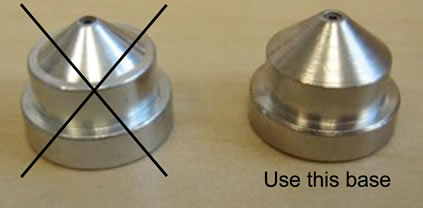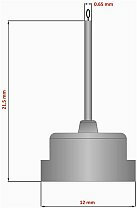An improved, high capacity (18 puck, 288 pins) automounter, based on the Berkeley Automounter (BAM), is implemented on both GM/CA ID beamlines.
![]() Puck Set / Tools
Puck Set / Tools
![]() Bases
Bases
![]() Pins
Pins
![]() Automounter Spreadsheets download
Automounter Spreadsheets download
![]() Automounter Spreadsheets filling instructions
Automounter Spreadsheets filling instructions
The automounter requires a complete puck tool set and specially sized bases and pins. Crystals will need to be pre-mounted in the pucks prior to arrival for beamtime.
Pucks Sets can be ordered from:
Crystal Positioning Systems, www.crystalpositioningsystems.com or MiTeGen, www.mitegen.com.
Qty. Item Price/Each
1 10" bent cryo tong
1 10" straight cryo tong
1 Puck pusher
1 Puck wand
7 Cryo puck
7 Magnetic cryo puck lid
1 Cryo puck shipping cane*
1 Puck separator tool
Total ~ approximately $3100
Loaner kits are available upon request.
*Shipping cane for Taylor Wharton CP100 shipping dewar or 34HC storage dewar.
We advise users to use ONLY "ALS style" or SPINE magnetic bases: either Hampton CrystalCap Magnetic ALS (part number HR4-779-ALS) or Hampton SPINE (part numbers HR8-xxx).

Hampton CrystalCap Magnetic: ALS-style on the right |

Hampton SPINE |
The above bases can be obtained at these sources:
The only pins which can be used with the robot are the "Hampton 18 mm" pins. This corresponds to breaking off the two end segments of a Hampton pin.
The image below details the assembled ALS-style base+pin ("18 mm") which is the preferred design for the automounter. The dimensions are fairly critical here, and the most important one from the automounter's standpoint is the distance from the inside mounting surface (which corresponds with the top of the goniometer magnetic mount) to the center of the crystal = 20.3mm ± 1mm.
It appears that the SSRL-style pins with the copper stem do not work well.

JBluIce/PyBluIce requires a Microsoft Excel spreadsheet file with samples descriptions to be loaded prior to using the automounter. The automounter templates are avalible for downloading through this link or after logging onto GM/CA computers, site files can be copied from the /px/data/ directory. The file names are:
Excel spreadsheet for 23ID-D & 23ID-B beamlines:
The number of rows is used to determine which style puck is loaded; so do not alter the number of rows. The spreadsheet may be populated with information or left blank.
Only three of the columns present in the spreadsheet are used by the screening system as described below. The rest of the columns are for your reference only and will not be displayed in the JBluIce/PyBluIce spreadsheet:
| Port: | refers to a port in the puck. The robot will use this port to retrieve the sample. Don't change this column. |
| CrystalID: | this label is used by the screening system to generate filenames. It is recommended that a unique ID be used for each sample. |
| Directory: | If provided, this field will be used to generate subdirectories for each sample under the root screening directory. The default template Excel spreadsheet uses the Port as the subdirectory name. |
ATTENTION: Please do not put any spaces into the spreadsheet filename or in Port, CrystalID and Directory columns. Instead, use underscores or dashes when a separator is needed.
Additional optional columns can be used to provide prior information for data processing and structure determination pipelines.
| Metal: | defines a metal in the crystal, if defined, the data will be processed as anomalous data. |
| ModelPath: | defines the PDB file to be used for ligand screening using DIMPLE. The files must be located in Downloads or Desktop directory if only the filename is given. Otherwise, the filename should be given in the full absolute path. |
| Spacegroup: | space group name (e.g. p21, p43212), defines a space group to be used in data processing. |
| SequencePath: | define the sequence file to be used by MR, similarly defined as ModelPath. |